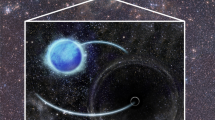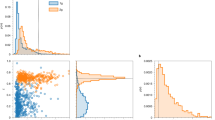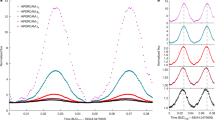Abstract
Galaxies are believed to evolve through merging1, which should lead to some hosting multiple supermassive black holes2,3,4. There are four known triple black hole systems5,6,7,8, with the closest black hole pair being 2.4 kiloparsecs apart (the third component in this system is at 3 kiloparsecs)7, which is far from the gravitational sphere of influence (about 100 parsecs for a black hole with mass one billion times that of the Sun). Previous searches for compact black hole systems concluded that they were rare9, with the tightest binary system having a separation of 7 parsecs (ref. 10). Here we report observations of a triple black hole system at redshift z = 0.39, with the closest pair separated by about 140 parsecs and significantly more distant from Earth than any other known binary of comparable orbital separation. The effect of the tight pair is to introduce a rotationally symmetric helical modulation on the structure of the large-scale radio jets, which provides a useful way to search for other tight pairs without needing extremely high resolution observations. As we found this tight pair after searching only six galaxies, we conclude that tight pairs are more common than hitherto believed, which is an important observational constraint for low-frequency gravitational wave experiments11,12.
This is a preview of subscription content, access via your institution
Access options
Subscribe to this journal
Receive 51 print issues and online access
$199.00 per year
only $3.90 per issue
Buy this article
- Purchase on Springer Link
- Instant access to full article PDF
Prices may be subject to local taxes which are calculated during checkout



Similar content being viewed by others
References
Springel, V. et al. Simulations of the formation, evolution and clustering of galaxies and quasars. Nature 435, 629–636 (2005)
Volonteri, M., Haardt, F. & Madau, P. The assembly and merging history of supermassive black holes in hierarchical models of galaxy formation. Astrophys. J. 582, 559–573 (2003)
Begelman, M. C., Blandford, R. D. & Rees, M. J. Massive black hole binaries in active galactic nuclei. Nature 287, 307–309 (1980)
Kulkarni, G. & Loeb, A. Formation of galactic nuclei with multiple supermassive black holes at high redshifts. Mon. Not. R. Astron. Soc. 422, 1306–1323 (2012)
Tonry, J. L. Constraints on the orbits of multiple nuclei in brightest cluster galaxies. Astrophys. J. 279, 13–18 (1984)
Barth, A. J., Bentz, M. C., Greene, J. E. & Ho, L. C. An offset Seyfert 2 nucleus in the minor merger system NGC 3341. Astrophys. J. 683, L119–L122 (2008)
Liu, X., Shen, Y. & Strauss, M. A. Cosmic train wreck by massive black holes: discovery of a kiloparsec-scale triple active galactic nucleus. Astrophys. J. 736, L7 (2011)
Schawinski, K. et al. Evidence for three accreting black holes in a galaxy at z ∼ 1.35: a snapshot of recently formed black hole seeds? Astrophys. J. 743, L37 (2011)
Burke-Spolaor, S. A radio census of binary supermassive black holes. Mon. Not. R. Astron. Soc. 410, 2113–2122 (2011)
Rodriguez, C. et al. A compact supermassive binary black hole system. Astrophys. J. 646, 49–60 (2006)
Wyithe, J. S. B. & Loeb, A. Low-frequency gravitational waves from massive black hole binaries: predictions for LISA and pulsar timing arrays. Astrophys. J. 590, 691–706 (2003)
Sesana, A. Systematic investigation of the expected gravitational wave signal from supermassive black hole binaries in the pulsar timing band. Mon. Not. R. Astron. Soc. 433, L1–L5 (2013)
Smith, K. L. et al. A search for binary active galactic nuclei: double-peaked [O III] AGNs in the Sloan Digital Sky Survey. Astrophys. J. 716, 866–877 (2010)
Fu, H., Myers, A. D., Djorgovski, S. G. & Yan, L. Mergers in double-peaked [O III] active galactic nuclei. Astrophys. J. 733, 103–109 (2011)
Fu, H. et al. A kiloparsec-scale binary active galactic nucleus confirmed by the expanded Very Large Array. Astrophys. J. 740, L44 (2011)
Blandford, R. D. & Königl, A. Relativistic jets as compact radio sources. Astrophys. J. 232, 34–48 (1979)
Hjellming, R. M. & Johnston, K. J. An analysis of the proper motions of SS 433 radio jets. Astrophys. J. 246, L141–L145 (1981)
Häring, N. & Rix, H.-W. On the black hole mass-bulge mass relation. Astrophys. J. 604, L89–L92 (2004)
Wilman, R. J. et al. A semi-empirical simulation of the extragalactic radio continuum sky for next generation radio telescopes. Mon. Not. R. Astron. Soc. 388, 1335–1348 (2008)
Kormendy, J. & Richstone, D. Inward bound—the search for supermassive black holes in galactic nuclei. Annu. Rev. Astron. Astrophys. 33, 581–624 (1995)
Komossa, S. et al. Discovery of a binary active galactic nucleus in the ultraluminous infrared galaxy NGC 6240 using Chandra. Astrophys. J. 582, L15–L19 (2003)
Fabbiano, G., Wang, J., Elvis, M. & Risaliti, G. A close nuclear black-hole pair in the spiral galaxy NGC3393. Nature 477, 431–434 (2011)
Kaastra, J. S. & Roos, N. Massive binary black-holes and wiggling jets. Astron. Astrophys. 254, 96–98 (1992)
Valtonen, M. J. et al. A massive binary black-hole system in OJ287 and a test of general relativity. Nature 452, 851–853 (2008)
Boroson, T. A. & Lauer, T. R. A candidate sub-parsec supermassive binary black hole system. Nature 458, 53–55 (2009)
Jiang, L. et al. The radio-loud fraction of quasars is a strong function of redshift and optical luminosity. Astrophys. J. 656, 680–690 (2007)
Koss, M. et al. Understanding dual active galactic nucleus activation in the nearby Universe. Astrophys. J. 746, L22 (2012)
Van Wassenhove, S. et al. Observability of dual active galactic nuclei in merging galaxies. Astrophys. J. 748, L7 (2012)
Hoffman, L. & Loeb, A. Dynamics of triple black hole systems in hierarchically merging massive galaxies. Mon. Not. R. Astron. Soc. 377, 957–976 (2007)
Blecha, L., Cox, T. J., Loeb, A. & Hernquist, L. Recoiling black holes in merging galaxies: relationship to active galactic nucleus lifetimes, starbursts and the MBH-σ* relation. Mon. Not. R. Astron. Soc. 412, 2154–2182 (2011)
Becker, R. H., White, R. L. & Helfand, D. J. The FIRST Survey: faint images of the radio sky at twenty centimeters. Astrophys. J. 450, 559–577 (1995)
Zwart, J. T. L. et al. The Arcminute Microkelvin Imager. Mon. Not. R. Astron. Soc. 391, 1545–1558 (2008)
Perley, R. A. & Butler, B. J. An accurate flux density scale from 1 to 50 GHz. Astrophys. J. 204 (Supp.). 19 (2013)
Kettenis, M., van Langevelde, H. J., Reynolds, C. & Cotton, B. in Astronomical Data Analysis Software and Systems XV (eds Gabriel, C., Arviset, C., Ponz, D. & Enrique, S. ) 497–500 (ASP Conf. Ser. 351, Astronomical Society of the Pacific, 2006)
Mauch, T. et al. A 325-MHz GMRT survey of the Herschel-ATLAS/GAMA fields. Mon. Not. R. Astron. Soc. 435, 650–662 (2013)
Noordam, J. E. & Smirnov, O. M. The MeqTrees software system and its use for third-generation calibration of radio interferometers. Astron. Astrophys. 524, A61 (2010)
Ulvestad, J. S., Perley, R. A. & Chandler, C. J. VLA Observational Status Summary. https://science.nrao.edu/facilities/vla/docs/manuals/oss2013b/performance/positional-accuracy (2009)
Paragi, Z. et al. The inner radio jet region and the complex environment of SS433. Astron. Astrophys. 348, 910–916 (1999)
Lobanov, A. P. Ultracompact jets in active galactic nuclei. Astron. Astrophys. 330, 79–89 (1998)
Hada, K. et al. An origin of the radio jet in M87 at the location of the central black hole. Nature 477, 185–187 (2011)
An, T. & Baan, W. A. The dynamic evolution of young extragalactic radio sources. Astrophys. J. 760, 77 (2012)
O'Dea, C. P. The compact steep-spectrum and gigahertz peaked-spectrum radio sources. Publ. Astron. Soc. Pacif. 110, 493–532 (1998)
Bianchi, S. et al. The NGC 3341 minor merger: a panchromatic view of the active galactic nucleus in a dwarf companion. Mon. Not. R. Astron. Soc. 435, 2335–2344 (2013)
Djorgovski, S. G. et al. Discovery of a probable physical triple quasar. Astrophys. J. 662, L1–L5 (2007)
Farina, E. P., Montuori, C., Decarli, R. & Fumagalli, M. Caught in the act: discovery of a physical quasar triplet. Mon. Not. R. Astron. Soc. 431, 1019–1025 (2013)
Ge, J. & Owen, F. N. Faraday rotation in cooling flow clusters of galaxies. 2: Survey. Astron. J. 108, 1523–1533 (1994)
Acknowledgements
We thank J. Magorrian, A. Karastergiou, S. Ransom and B. Fanaroff for discussions. The European VLBI Network is a joint facility of European, Chinese, South African and other radio astronomy institutes funded by their national research councils. e-VLBI research infrastructure in Europe was supported by the European Union’s Seventh Framework Programme (FP7/2007-2013) under grant agreement number RI-261525 NEXPReS. The financial assistance of the South African SKA Project (SKA SA) towards this research is acknowledged. Opinions expressed and conclusions arrived at are those of the authors and are not necessarily to be attributed to the SKA SA. Z.P. and S.F. acknowledge funding from the Hungarian Scientific Research Fund (OTKA 104539). Z.P. is grateful for funding support from the International Space Science Institute.
Author information
Authors and Affiliations
Contributions
R.P.D. was the Principal Investigator of the project and wrote the paper. Z.P. helped design, schedule, observe and calibrate the EVN observations as well as interpret the results. M.J.J. helped interpret the cosmological and astrophysical importance of the discovery and contributed significantly to the text. M.C. and R.P.F. helped in the binary SMBH interpretation and the physics thereof. S.F. calibrated the 1.7 GHz EVN observation and helped in the VLBI component interpretation. G.B. and I.H. helped with the technical aspects of the JVLA re-analysis and the subtle interferometric effects at play. H.R.K. helped in the VLBI and GMRT proposals and wrote the software to calibrate the GMRT observation. K.G. and C.R. observed and calibrated the 16 GHz AMI observations. All authors contributed to the analysis and text.
Corresponding author
Ethics declarations
Competing interests
The authors declare no competing financial interests.
Extended data figures and tables
Extended Data Figure 1 Radio spectrum of the radio components in J1502+1115.
Both J1502S (open red squares) and J1502P (grey squares) are steep-spectrum radio sources between 1.4 and 8 GHz, as measured by JVLA observations. The two flat spectrum cores (J1502SE/SW, filled circles) are the likely cause of the flattened spectrum of J1502S at higher frequency, as measured by the AMI 15.7 GHz detection labelled as J1502+1115 (AMI). Error bars, ± 1s.d. on the flux measurement. J1502+1115 (GMRT) indicates the 610 MHz detection using the GMRT (Methods). Note that J1502SE and J1502SW are shown marginally offset in frequency purely for clearer illustration.
Extended Data Figure 2 Larger field-of-view JVLA 5 GHz map of J1502+1115 to demonstrate map fidelity.
The colour scale shows the same JVLA 5 GHz residuals shown in Fig. 1c but with the full 128 × 128 pixel median map generated from the Monte Carlo realizations. The small filled red square indicates the map boundary of the VLBI map shown in Fig. 1a. The red cross denotes the centroid of the point source subtracted J1502P component. Contour levels are the same as in Fig. 1c. The grey ellipse (lower left) represents the FWHM of the Briggs-weighted (robust = 1) PSF, while the white dot shows the VLBI 5 GHz PSF.
Extended Data Figure 3 Zoom-in of the high-brightness-temperature inner jet emission of J1502S.
The colour scale shows the same JVLA 5 GHz residuals shown in Fig. 1c but imaged with Briggs uv-weighting (robust = 0) to highlight the position angle of the inner northeast J1502S jet. This is misaligned with the vector between J1502SE and J1502SW (red dots) by ∼45°. The black JVLA 5 GHz contours start at 60 μJy per beam (∼2σ) and increase in steps of 1σ. The grey ellipse (lower left) represents the FWHM of the Briggs-weighted (robust = 0) PSF, while the white ellipse shows the VLBI 5 GHz PSF. The red square indicates the map boundary of the VLBI map shown in Fig. 1a.
Rights and permissions
About this article
Cite this article
Deane, R., Paragi, Z., Jarvis, M. et al. A close-pair binary in a distant triple supermassive black hole system. Nature 511, 57–60 (2014). https://doi.org/10.1038/nature13454
Received:
Accepted:
Published:
Issue Date:
DOI: https://doi.org/10.1038/nature13454
This article is cited by
-
From Nearby Low Luminosity AGN to High Redshift Radio Galaxies: Science Interests with Square Kilometre Array
Journal of Astrophysics and Astronomy (2016)
-
A tight duo in a trio of black holes
Nature (2014)
Comments
By submitting a comment you agree to abide by our Terms and Community Guidelines. If you find something abusive or that does not comply with our terms or guidelines please flag it as inappropriate.



